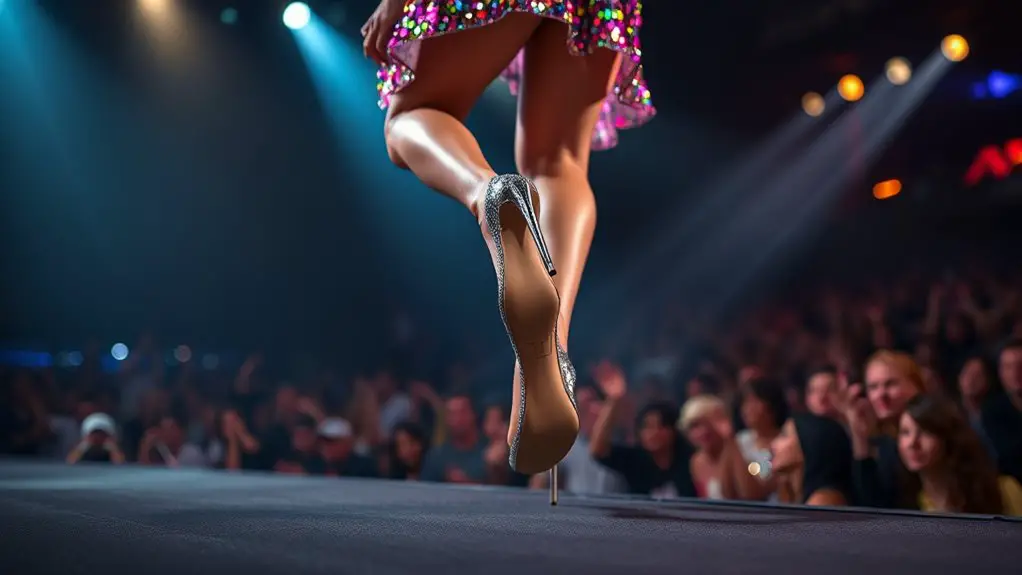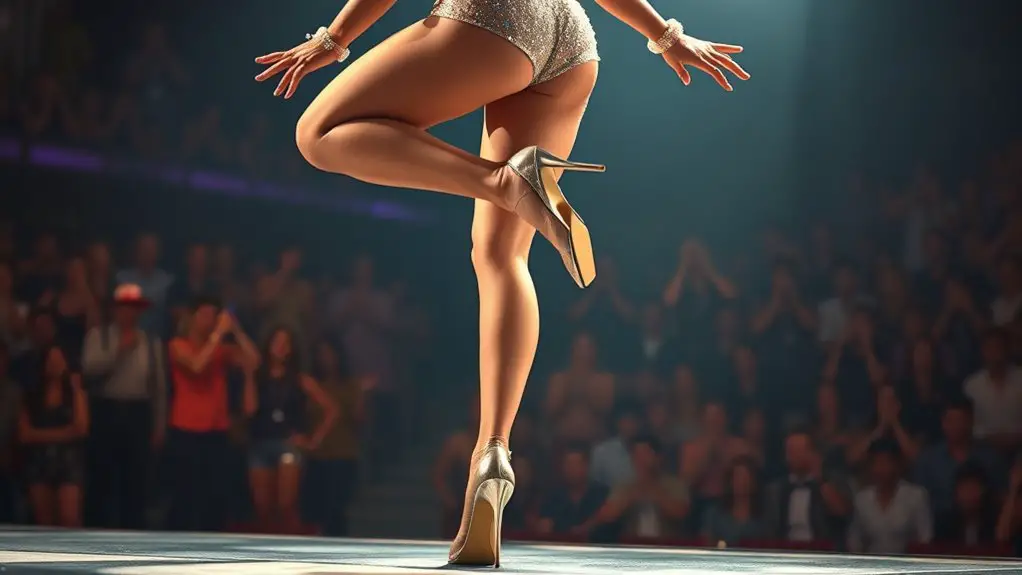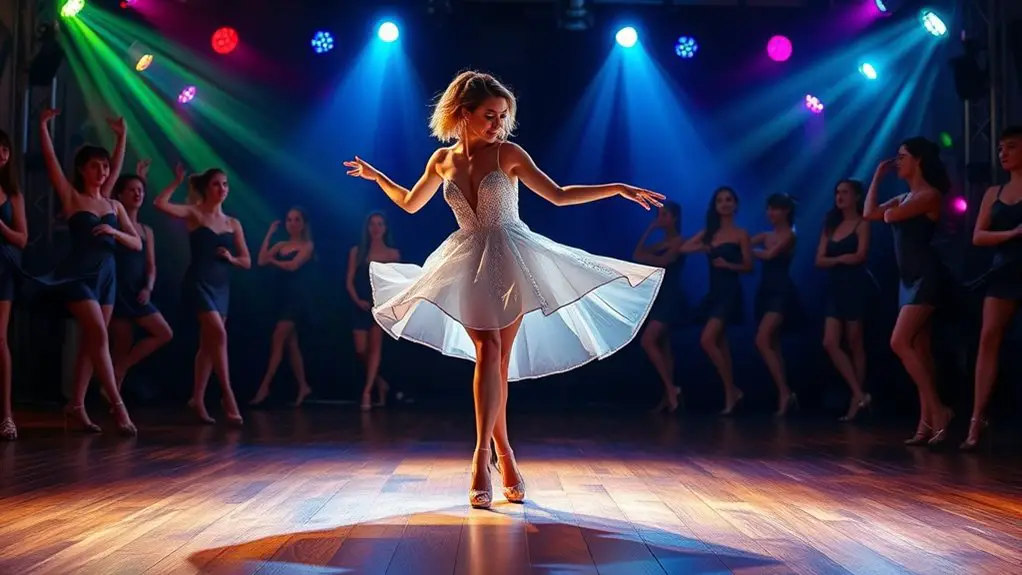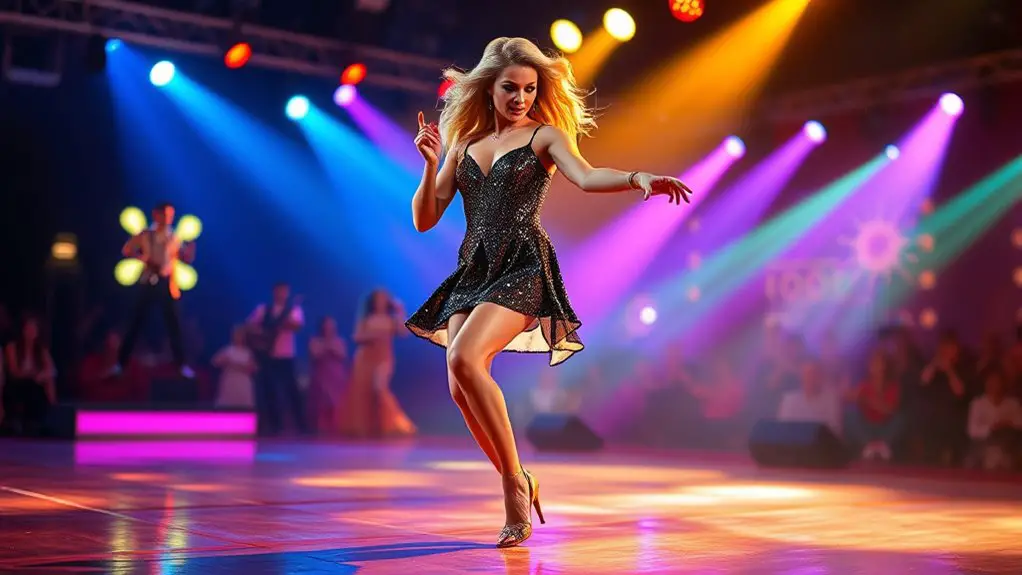To master dancing in heels, you need to focus on key techniques and body mechanics. Cultivating core strength and flexibility is essential for maintaining balance and agility. Selecting the right footwear is equally important; it should provide support and comfort. Pop stars harness these elements through practice, allowing them to perform confidently. Additionally, iconic performances often showcase how heels can amplify artistry. For a deeper understanding, you’ll discover more about the evolution of heels and performance strategies.
The Evolution of Heels in Pop Culture

As heels began to rise in popularity, their impact on pop culture became undeniable, transforming not just fashion but also societal perceptions of femininity and power. You can see how heels have evolved from being a symbol of aristocracy in the 17th century to a staple in contemporary wardrobes, reflecting shifting ideals of womanhood. Their historical significance lies in how they’ve served as a tool for empowerment, allowing individuals to assert their presence and confidence in various social settings.
Culturally, heels have been embraced and critiqued, often embodying the tension between sexuality and professionalism. Icons like Madonna and Beyoncé have harnessed heels to enhance their performances, solidifying their status as powerful figures. Fundamentally, heels are more than mere accessories; they’re cultural artifacts that challenge and redefine gender roles while celebrating the intersection of fashion and identity. You can’t underestimate their far-reaching influence on how society views femininity today.
Understanding the Mechanics of Dancing in Heels
While many dancers may feel intimidated by the prospect of performing in heels, understanding the mechanics behind it can reveal a new level of expression and confidence. The key lies in heel biomechanics and foot alignment. When you wear heels, your center of gravity shifts, requiring an awareness of how to distribute your weight effectively. Proper foot alignment becomes essential; your feet should be positioned to support your arches and maintain balance.
As you engage your core and activate your leg muscles, you’ll find that your movements can be both fluid and powerful. Understanding how your body interacts with the heels allows you to express yourself more freely, rather than feeling restricted. By mastering these mechanics, you’ll not only enhance your dance technique but also build the confidence to own the stage. Embrace the challenge, and you’ll discover the art of dancing in heels as a compelling extension of your identity as a performer.
Essential Techniques for Balance and Stability

To achieve balance and stability while dancing in heels, it’s crucial to cultivate a strong foundation through specific techniques. Start by integrating balance techniques, such as practicing weight shifts from one foot to the other. This not only enhances your proprioception but also helps you become more aware of your body’s center of gravity. Consider incorporating stability exercises like single-leg stands or yoga poses, which strengthen your ankles and improve overall coordination.
Additionally, focus on your posture; keeping your spine aligned and shoulders relaxed can greatly affect your equilibrium. When you engage your core, you’ll find it easier to maintain stability, allowing for more fluid movements. Remember, it’s all about finding your center and trusting your body. By consistently practicing these techniques, you’ll develop the confidence and poise needed to navigate the dance floor in heels like a pro.
The Importance of Core Strength and Flexibility
Core strength and flexibility are essential for mastering the art of dancing in heels, as they provide the fundamental support and fluidity needed for enchanting performances. When you engage your core, you’re not just stabilizing your body; you’re enhancing your balance and control, important when maneuvering the challenges of elevated footwear. Core stability allows you to execute precise movements, shifting your weight effectively and maintaining poise.
On the other hand, flexibility training complements this by ensuring your muscles can stretch and contract efficiently, which is critical for those dynamic dance moves. It reduces the risk of injury and empowers you to perform with grace and agility. By prioritizing these elements in your routine, you’re setting a strong foundation for your dancing. Ultimately, the seamless integration of core strength and flexibility not only elevates your performance but also transforms your confidence on stage.
Choreography: Designing Moves for High Heels

When crafting choreography for dancing in heels, it’s vital to contemplate the unique dynamics that elevated footwear introduces. You’ll find that choreography styles must adapt to accommodate the added height and pressure on the feet. Consider how foot placement and weight distribution change with heels; your movements need to reflect these adjustments.
Heel adaptations, such as incorporating fluidity in shifts, can enhance the overall performance. Think about how to use your hips and core to maintain balance while executing sharp turns or intricate footwork. It’s important to develop moves that emphasize grace without sacrificing stability.
Additionally, incorporating levels—shifting from standing to lower poses—can create striking visuals while ensuring comfort. Ultimately, the goal is to design choreography that showcases your artistry while embracing the challenges posed by dancing in heels. Embrace the journey of mastering these elements, and your performance will shine.
Footwear Selection: Finding the Right Pair
When choosing heels for dancing, you need to carefully consider heel height and how it impacts your balance and movement. The material of the shoe plays an essential role in comfort, affecting your stamina on the dance floor. Finding the right pair isn’t just about style; it’s about ensuring you can perform with confidence and grace.
Heel Height Considerations
Choosing the right heel height is essential for both comfort and performance on the dance floor, especially since different styles of dance may require varying levels of elevation. Understanding heel types and their associated comfort levels can considerably enhance your dancing experience. Consider these factors when selecting your heels:
- Height Variation: Lower heels (1-2 inches) provide stability, while higher heels (3-4 inches) can elevate your posture but may compromise balance.
- Dance Style: Styles like ballet may benefit from moderate heels, while hip-hop often accommodates lower options for grounded movements.
- Foot Shape: A heel’s design should accommodate your foot’s unique shape, affecting both comfort levels and overall performance.
Material and Comfort Factors
While the aesthetic appeal of dance heels often takes center stage, the materials used in their construction can considerably impact your comfort and performance. When selecting the right pair, you must consider material flexibility and comfort cushioning. A heel that offers flexibility can adapt to your foot’s movements, allowing for fluidity in your dance. Look for shoes made from breathable fabrics that provide support without sacrificing style. Additionally, comfort cushioning is essential; it absorbs shock and reduces strain on your feet during those high-energy routines. A well-cushioned insole can make a significant difference, especially during long performances. Ultimately, finding the right balance between style and comfort will enable you to dance confidently and gracefully, no matter how high those heels go.
Building Confidence Through Practice and Performance
Building confidence in dancing, especially in heels, often hinges on the repetitive nature of practice and the thrill of performance. As you engage in confidence building, you’ll discover that each session can considerably diminish performance anxiety. Here are three key strategies to enhance your confidence:
- Repetition: Practice your routines consistently to internalize movements. The more familiar you become with choreography, the less intimidating it feels.
- Visualization: Before stepping onto the stage, visualize yourself executing your dance flawlessly. This mental rehearsal can help ease nerves and foster a sense of control.
- Positive Reinforcement: Celebrate small victories during practice; acknowledging progress can bolster your self-esteem and prepare you for live performances.
Iconic Performances That Showcase Heels
When you think of iconic performances, certain heel moments instantly come to mind, showcasing not just style but also impressive dance techniques. These performances highlight how heels can elevate both the aesthetic and technical aspects of dance, pushing boundaries and redefining movement. By analyzing these memorable instances, you can uncover the artistry behind the choreography and the confidence that heels instill in the dancer.
Memorable Heel Moments
Whether you’re a seasoned performer or an enthusiastic spectator, iconic performances that showcase heels leave an indelible mark on the world of dance. These memorable performances highlight the skill and boldness of iconic artists, turning heels into symbols of empowerment and artistry. Here are three standout moments:
- Beyoncé’s “Single Ladies” – Her sharp, precise movements in stilettos redefine confidence in heels.
- Lady Gaga’s VMA Performance – With each step in towering platforms, she challenges conventional dance norms while exuding fierce individuality.
- Madonna’s “Vogue” – The fusion of high fashion and dance in heels exemplifies her influence on pop culture.
Each performance is a demonstration of the artistry involved in mastering heels, transforming footwear into a powerful extension of self-expression.
Dance Techniques Revealed
The artistry of dancing in heels goes beyond mere performance; it involves mastering specific techniques that enhance both movement and expression. You’ll notice that pop stars often blend various dance styles, from hip-hop to jazz, showcasing their versatility while maintaining poise in heels. Each heel variation—whether stilettos, block heels, or platforms—requires distinct body alignment and footwork. For instance, when executing a sharp turn, your weight distribution must shift seamlessly to maintain balance. Iconic performances highlight this mastery; watch how a star shifts between intricate footwork and fluid upper body movements, effortlessly commanding the stage. Understanding these dance techniques not only elevates your performance but also deepens your appreciation for the skill involved in dancing in heels.
Overcoming Challenges: Injury Prevention and Care
While dancing in heels can elevate your performance and confidence, it also presents unique challenges that require careful attention to injury prevention and care. To protect yourself and enhance your longevity in this demanding art form, consider these essential care strategies:
- Footwear Selection: Choose heels that provide adequate support and cushioning, ensuring you can maintain stability during elaborate routines.
- Strengthening Exercises: Incorporate foot and ankle exercises into your routine. Building strength and flexibility in these areas can greatly reduce the risk of injuries.
- Warm-Up and Cool-Down: Always warm up before rehearsals or performances and cool down afterward. This practice not only aids in injury prevention but also enhances recovery.
The Future of Heels in Pop Music Performance
As you look ahead, the intersection of evolving footwear technology and pop music performance is poised to redefine how artists express themselves on stage. With innovative designs enhancing comfort and style, you’ll see dance styles adapting to these advancements, allowing performers to push their physical limits. Fashion trends will not only dictate aesthetics but also influence the very essence of how heels are integrated into the choreography of tomorrow’s hits.
Evolving Footwear Technology
Innovations in footwear technology are reshaping the landscape of high-heeled performance in pop music, enabling artists to push boundaries like never before. As a performer, you’ll appreciate how these advancements not only enhance your comfort but also elevate your stage presence. Here are three key footwear innovations that are revolutionizing your performances:
- Lightweight Materials: New composites reduce weight without sacrificing durability, allowing for more agile movements.
- Shock-Absorbing Soles: Enhanced cushioning technology minimizes impact, providing greater support during intense routines.
- Customizable Fit: Advanced sizing systems guarantee a tailored fit, reducing the risk of injury and enhancing overall performance.
These performance enhancements empower you to deliver enchanting shows while maintaining the elegance that high heels symbolize.
Influence on Dance Styles
The advancements in footwear technology are not just enhancing comfort; they’re also influencing the dance styles that dominate pop music performances. As you observe the evolution of pop choreography, you’ll see how heels are shaping the way artists express themselves. The integration of modern heel designs allows for more dynamic movements, blending traditional styles with contemporary flair.
Here’s a visual representation of these dance influences:
| Dance Style | Key Characteristics | Influence of Heels |
|---|---|---|
| Hip-Hop | Fluid, energetic movements | Increased agility |
| Contemporary | Expressive, fluid motion | Enhanced artistic flair |
| Jazz | Sharp, rhythmic actions | Better posture |
As style evolution continues, expect heels to remain a staple, pushing boundaries in pop performances.
Fashion Trends in Performance
While heels have long been a symbol of style and sophistication, their future in pop music performance is poised to redefine not just fashion, but also the very essence of artistic expression. As you observe the evolution of heels on stage, you’ll notice how they create powerful fashion statements that enhance performance aesthetics.
Consider these key trends:
- Bold Designs: Expect to see avant-garde heels that push boundaries, merging art with footwear.
- Comfort Innovations: Brands are now prioritizing comfort, integrating tech to make dancing in heels more feasible.
- Sustainable Materials: Eco-friendly options are becoming popular, aligning with the growing demand for responsible fashion.
Ultimately, the way heels are embraced in pop culture reflects broader shifts in creativity and identity.
Frequently Asked Questions
How Do Different Heel Heights Affect Dancing Ability?
Dancing in heels is like walking a tightrope; heel height dramatically influences your balance technique. Shorter heels offer stability, while taller ones challenge your core strength, enhancing grace but demanding precise control and adaptability in movement.
What Are the Best Heel Types for Beginners?
When choosing comfortable heels for beginners, opt for block heels or wedges. These styles offer better stability and support. Proper heel selection can greatly enhance your confidence and overall dancing experience, making it more enjoyable.
Are There Specific Warm-Up Exercises for Dancing in Heels?
Think of your body as a finely-tuned instrument; warm up routines and flexibility exercises are essential. Focus on ankle rotations, leg stretches, and hip openers to enhance your grace and prevent injury while dancing in heels.
How Can One Improve Foot Strength for Heel Dancing?
To improve foot strength for heel dancing, focus on foot exercises like toe raises and resistance bands. Incorporating balance training, such as single-leg stands, can enhance stability, ensuring you feel confident and secure while dancing.
Do Pop Stars Ever Dance Barefoot During Performances?
While it’s rare, some pop stars do perform barefoot. The barefoot advantages include enhanced flexibility and a stronger connection to the stage, allowing for more expressive movements that can captivate audiences in unique ways.



